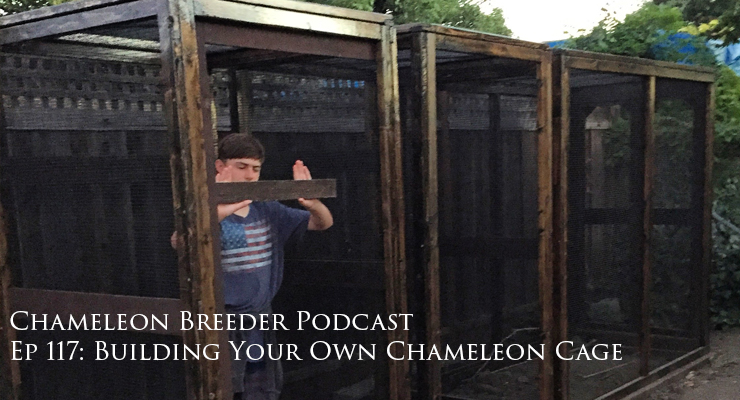117: Building Your Own Chameleon Cage

In the beginning most of us made our own cages. There were a few chameleon cage manufacturers around if you knew where to look, but home made cages were very common. These were educational, sometimes miserable, projects of passion. I had a wonderful time learning how to work with wood and what it took to build large outside cages. Some of the pieces of my first outdoor caging from over 20 years ago are still acting as garden trellises for my mother’s garden. I experimented with sealing wood with bees wax. I can tell you that process was laborious and expensive. It took many weekends to finish. But, boy, did that cage last a long time.
Of course, we all experimented with screening and, yes, it is a skill that can be developed and, yes, it takes a couple of ugly panels to work it out. It looks easier than it really is. If you want to include screen panels then buy the right tools and just plan for a learning curve to get those panels sufficiently taut. And don’t beat yourself up if you don’t get it right away. It takes time
To start this off we have to get the basic buy vs. make decision out of the way.
Good reasons to make a cage
Cage size does not exist. Each of us has different backyard and room set-ups and have different spaces to work with. You are going to hear the phrase “bigger is better” a lot when talking about chameleon caging. The primary benefit to making your own cage is that you can build a cage that takes up all your space. The more space you have the more microclimates and just plain beauty you can put in the cage. The space you have may not be represented by a commercially available cage. If you have 5’ wide by 5’ tall space consider making a cage that fits those dimensions. This, of course, depends on your construction skill and time available. We all have different thresholds. My threshold is this. I have the skills to create something that would look good in the backyard, but not something that would look good enough in the living room. I could develop the skills to do living room work, but I am not interested in spending the time to develop those skills for something I will make one of. My life is pretty full and I can’t remember the last time I did not have my life planned down to the hour. Between work that pays the mortgage, family, and taking care of the chameleon activities there isn’t anything left. If I decide to spend my afternoon building a new outdoor cage I am taking that away from something else. That is just the way it works. And I have to make that decision. It is healthy to have that time to make things with your hands. And it is not like you have to overthink it, but do value your time. If you want to make your own cage, I highly suggest you do not make a 2’x2’x4’ screen cage or anything else that is out there. Make a cage because you are making something that is better for your situation. That is time spent adding value to your chameleon’s life. That is worth your time.
Another good reason to build your own cage is that you have the skills or it would be fun to develop the skills. Building cages is worthwhile because you get to feel like you are at the ground level of building your chameleon’s environment. There is a sense of satisfaction behind it. But, let’s be clear that there needs to be a level of proficiency in design and tools involved in doing so. Many people have woodworking skills or can practice and develop screening skills. This whole process can be therapeutic, but come at it fully aware that a functional cage is not just a few walls thrown together. There may be tools you need to do the job right. And finding the right materials may take some work. I have to special order and then take a short road trip to pick up 4’ wide PVC coated hardware cloth for my outdoor cages. Once you start making your own cages you start becoming adept on sourcing all those parts! There are skills required so go into this ready to learn and practice.
My favorite reason to build my own cage is because what I need doesn’t exist. This is where we get the innovation that moves us forward as a community. In fact, my Dragon Strand Chameleon Caging Company was started because of this very reason. I was doing wholesale breeding and I wanted an attractive and organized way of individually raising baby chameleons. We know the babies grow faster, less stressed, and without bite marks or nipped tails when they are raised individually. It was worth the investment to me to be able to offer a better quality chameleon. I commissioned the Nursery Cage System to be built by some experienced manufacturers and was so happy with them that I decided to make the cages available for sale and expanded the concept to a rack compatible breeder series. And that is how Dragon Strand started. So, if you need something and it doesn’t exist, make it!
A Not-So-Good Reason to Make a Cage
There is really only one warning flag reason to make a cage in my mind. And that is to save money. Saving money by making a cage is like making money breeding chameleons. 90% of the people who say they are doing it are not properly counting all the costs. You can save money by making cages if you have the tools and are making many cages that the initial cost of any additional tools can be spread out over the entire build project. This also allows you to have less excess material left over after the build. It doesn’t matter if you used it or not. You had to buy it.
Here is the inside look at those people that post that they made this cage for $10. They are usually not including in the cost of the tools they had to purchase – or they already had laying around- and they are not including the excess material they had to buy but was not used. And, of course, no one ever calculates the cost of time spent learning how to do it and building the skills necessary to make something picture worthy. Considering how inexpensive some of the cheap imported cages are, it is difficult to make something for less money that would be of the same quality.
Should I Spend the Time Making My own Chameleon Cage?
How do you decide if you should spend the time building a cage? First of all, my basic guideline has always been if what I want exists already I buy it. If it doesn’t exist I make it. If you want a 2’x2’x4’ tall screen cage then don’t build it. They are all over the place. There are tools and skills necessary to make it look nice. If the end product is going to look like something you can pick up somewhere then I suggest you just pick it up, have something that looks good, and spend your time with your family or starting that Green banana Roach colony. The real power of making a cage is creating something that is perfect for your situation that commercially made cages cannot offer.
Chameleon Cage Making Considerations
Now, the purpose of this episode is not to tell you how to build the cage or give blueprints. Everyone’s situation is different and you will have to select the proper materials and design that corresponds to your application and environment. But I am going to lay out some basic considerations for when you are in that design stage and making those initial decisions.
Considerations
- Material: Unless there is some reason why you are throwing together a bunch of cages and then will throw them away – use high quality materials. Here is where that mentality that you are saving money will bite you. You do not have to be extravagant. Go ahead and leave the gold plated door handles out of this. But get quality materials that won’t break or rust. Every cage looks good when you are finished. But think about three years from now. Your plants have settle in and the cage has a natural feel to it. This is a bad time to have to replace a side of the cage because it is rotted or rusted out. Get the materials you need. Make sure the fine screening is aluminum. Pay extra for PVC coated hardware cloth. And if wheels will benefit you then do not hesitate to get the wheels. Casters can be $12 each, but being able to move the cage so I can clean behind it, find an escaped gecko, or be able to reach that infernal cricket that keeps chirping at 2AM is worth every penny. I have never regretted putting my cages on wheels.
- Be Patient: Like using quality materials, Don’t cut corners in your process. Multiple coats of paint or stain take time. And, gosh, when you have all the pieces cut you want to put the thing together! Who wants to wait around to seal the wood or stain it much less do multiple coats. But do it anyways. Once this cage is up it will last for years. And fixing the cage is a huge pain. Do it right in the beginning.
- Dimensions: Bigger is better, right? Well, mostly. Make sure you can reach anywhere inside the cage. There is a reason why my Dragon Strand cages do not go beyond 24” in depth. That is simply because 24” is the maximum comfortable reach of a standard adult. If you go beyond that you are creating a place in your cage that is difficult to maintain. And that is why I have designed any cage beyond 24” deep to be a walk-in cage. And that takes care of the reach issue. Make sure you don’t create a difficult situation for yourself. All of my three or four foot deep cages have doors big enough for me to step in. It may not be comfortable, but it can be done if I need to for whatever reason.
- Plan for your water cycle up front. How will you get water into this cage and where will it go once it flows through? Simple, and elaborate, drainage tables have been constructed. I once used rain gutters that emptied into a self-priming pump. Drainage should not be an after-thought or something that you will figure out later. If you are making an outdoor cage then drainage is not really an issue, but if this is for your indoor chameleon room or living room then drainage is a critical component. Plan for it ahead of time. A dresser or low cabinet that your cage sits on can provide an attractive place to hide your misting system water reservoir or drainage bucket.
- We have all tried to integrate dividers into our designs. This is where we build a dual cage system with a common wall and part of the wall slides out so that the occupants of each can interact. Sounds like a great feature for allowing a natural introduction between the male and female. My experience is that dividers are not used as much as you would think and, although they are an in-demand feature, the effort and expense that goes into designing and building in a working divider does not pay off in benefit. Especially since most chameleons species can handle being moved around by a human a couple times a year without an issue. But that is just one man’s opinion and experience. If this is just too good of an idea to pass up then have at. There is no harm in putting one in.
- Fountains: It is common for Do-It-Yourselfers to think that a fountain would be an excellent thing to plan for and add in. I want to caution you that all the advice saying not to add a fountain into a chameleon cage still applies when you make your own cage. Even a large cage. Someone somewhere will be the exception and will be putting in the ongoing effort to make it work. I am still willing to say not to do it. And when that person steps forward please ask everything they are going through to make it work and then you can decide if it is worth it to you.
- Repurpose cabinets, greenhouses, bird cages,etc…: Anything that already is a structure can be a great starting point for you to work off of. You have to be smart about how you water proof it, account for ventilation, and install lighting. One caution I will give though is aquariums. Aquariums are difficult beasts for us. And when I say aquarium I mean the ones that are sealed up so they can hold water. Glass terrariums with built in ventilation are different things. We need air flow and aquariums are designed to have zero flow of anything. Yes, you can put a screen cage on top of the aquarium and yes you can figure out a way to create airflow using fans. But you soon end up putting so much work into modifying the system that the end result is either a standard chameleon cage set-up that has an aquarium attached and would work just great without the aquarium, or it would have been cheaper and easier to just buy the proper cage. Aquariums do great at holding fish. Repurposing them to hold a tree edge from six feet off the ground is a tall order. It can be done, but this falls into the category of why go through that effort to make an aquarium something it is not.
- Electricity: Please know what you are doing. Electricity can cause fires. We don’t hear about this often, but we still hear about fires from electricity in reptile rooms often enough to know the danger is real. We have a number of things that need power and we have ample water being used in our systems. The combination could be dangerous so make sure you have your electrical plan made up and do not cut corners with anything that plugs into the wall.
- UVB: Most, if not all, the standard community advice for UVB is for a UVB bulb going through screen which can cut out 50% strength. If your cage has a solid top and your UVB bulb is mounted on the inside top then you now have a much stronger UVB source. Account for that in your plans as to where you put the basking branch. On one hand, you can’t put the basking branch as close as you are used to. On the other hand, if you are dealing with a larger area then you may wantthat more powerful UVB source. I am mentioning this as a consideration just so you have it as part of your plan. Like everything, these are all tools and will work out beautifully if they are used properly.
Outdoors Enclosures
One of the most obvious applications to build your own cage is for outdoor enclosures. Outdoors is a chance for you to really embrace your options. This is where I build 4’x4x 7’ tall cages for a single Jackson’s Chameleon or a 8’ wide x 4” deep x 7’ tall cage for my male Parson’s Chameleon. If you have that kind of space then the investment in tools, materials, and the time to figure it out is well worth the end result of a heavily planted walk-in enclosure.
Now, outdoors has a whole new set of considerations. You have sunlight, wild animals and neighbors. We have covered sunlight in other episodes. It is intense and will fry your chameleon. All those UV Index readings you see from your chameleon’s homelands? Your chameleons are hiding during those levels. They are hiding in the trees and bushes. So make sure you are providing them trees and bushes. Design-wise, that just means space for large plants and you can’t wait for the plants to fill in for a year. You need to provide cover. Sometimes this means using black shade cloth, but it will probably mean that you spend the money on mature plants up front. And make the bottom of the cage soil. This provides the natural humidity and heat sink properties as well as giving you the ability to have healthy plants. This means you need to have a good plan for the point where you cage will touch the ground. Here is where a pressure treated wood frame base or even a concrete ring comes into play. But have a plan for your cage meeting the ground. I have used a brick platform before and have used pressure treated lumber. Both worked well for me.
For wild animals you have birds and mammals that will try to get your chameleon if your chameleon is crawling or sleeping on the sides. One way to prevent this problem is to frame your cage walls with 2x4s or 2x3s and screen both sides of the frame with ½” or ¼” PVC coated hardware cloth. That 1 ½” of thickness between the mesh layers is enough to protect from many birds and claws, but even that wouldn’t be a perfect protection. Know your local wildlife and do what protection is necessary. Many of our outdoor cages are up against walls and, of course, walls are the highways for critters giving them ample opportunity to notice a chameleon on the side of the cage. I have, surprisingly, had no problem with putting my aluminum screen cages on planter boxes with wheels. The aluminum mesh would not stand up against a crow or racoon or rats that wanted to get in, but having these planter box cages out on the patio away from the walls has done a good job of keeping trouble away. I did have one break in and that was once when the cage was in the garage for the night and next to some shelving which rats climbed up on and wanted the feeder insects inside.
And finally, neighbors. Neighbors are strange things. I prefer to make cages the height of the walls so they are not noticed by my neighbors. But even that will not defend against nosy neighbors. On one occasion some crazy lady looked out her 2ndstory window and saw my cage hidden in the trees. She then become hyper aware of everything that went on and eventually accused me of being responsible for the opossum population. The next crazy lady neighbor accused me of being responsible for the cricket population. Pointing out that the native cricket species, which I did not use as feeders, had been there all along did nothing to dissuade her. A cricket is a cricket and suddenly she was noticing crickets came out at night. Must be my fault. And neighbors will go to extreme lengths to be in your business. The cricket lady could not see into my backyard unless she stood on her bathtub. She was literally risking her life to be nosy. She called the city on me and we went back and forth. Note, at no time was a cage visible from their backyard or did I have an escaped chameleon or did my activities affect her life at all – except when she was risking her life staring into my backyard from on top her bathtub. But this is what neighbors do. So I suggest being as discrete as possible. Do your best to hide what you are doing from your neighbors and especially from any view from the street. Chameleons have been known to be stolen from backyards. When my last neighbor got nosy as to why I had a bunch of vines in a screened in enclosure I informed him that I raised rare passionflowers and I wanted to keep the birds from stealing the fruit. So consider making the cage up to the level of the wall to avoid questions in the first place and then plant vines around it to, at least make it look like a thing of beauty. There is only so much you can do to disguise a 6 or 7 foot high wood frame, but lots of flowers make neighbors happy and distract their imagination from the horrible beasts you are keeping and the biblical plagues you are preparing to unleash upon the world. And don’t tell them you feed roaches or a rabid mob will show up at your door step in no mood to get a lesson on the differences between blaptica dubia and Periplaneta Americana.
Making your own cage can be a rewarding project and can be a be a way of providing a better life for your chameleon. And it is especially useful in opening up your backyard to chameleon keeping. Evaluate your skill level and time available, ask whether it already exists or not, and, if not, then it is time to draw up some plans!
And, I have to say, I think everyone should seal a wood cage with bees wax at least once in their life! It builds character and a whole lot of patience!











